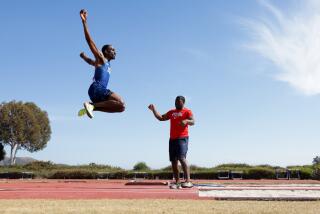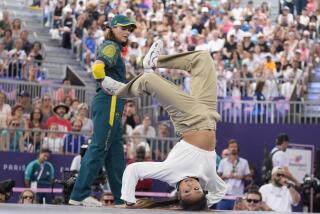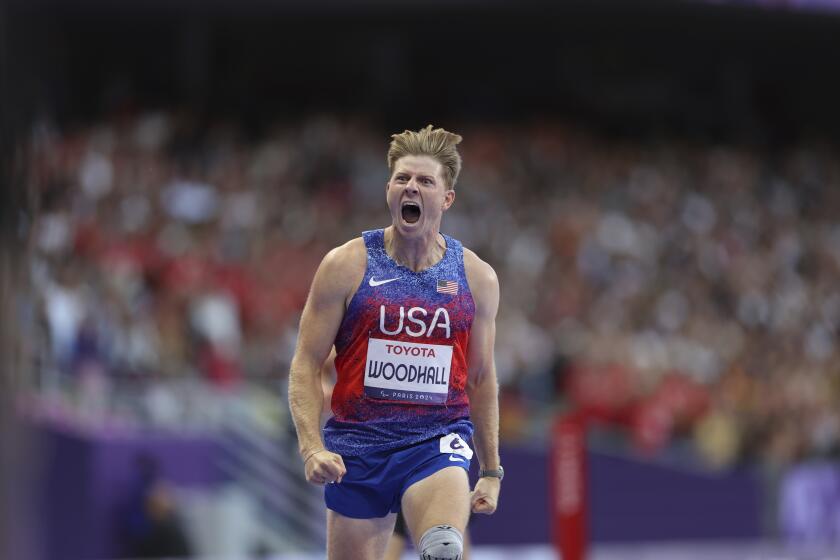Science / Medicine : Science of Seoul : The race for gold medals has sent U.S. athletes back to laboratory drawing boards to put their training under scrutiny of biological and technological analysis.
COLORADO SPRINGS — Marty Froelick, flanked by sports scientists, is running on a treadmill in the physiology lab of the U.S. Olympic Committee’s Sports Science Program. The third-ranked marathoner in the United States hopes to find out if he has the right stuff--cardiovascular and biochemical at least--for the Olympic trials in his event only two weeks away.
Froelick wears electrodes and a transmitter strapped around his torso to register heart rate. He puts on a special plastic headgear with a tube to insert in his mouth for measuring his breathing rate. These data will enable a computer to monitor his VO2 max, or capacity to process oxygen, the best single indicator of fitness.
A researcher pricks his right finger with a needle, drawing a blood sample. Another researcher runs the blood through a device to measure lactic acid, the chief cause of muscle fatigue. A digital wall clock flashes red numbers: a 6:00-per-mile pace.
Soon the treadmill shifts to 5:30, then 5:00. Froelick is running much faster now. The test falls into a rhythm: headgear on, pricked finger, blood lactate measured, headgear off, VO2 readout, pace quickened, and so on. Finally, the pace speeds to 4:45.
He wants to see how far he can push himself without blacking out.
In 1985 the marathoner took the first of several treadmill tests in this same laboratory. He wanted to find out how well he responded to physical stress. Researchers evaluated heartbeat, muscle force, pulmonary function, general metabolism, and aerobic-anaerobic capacities. Exercise physiologist Peter Van Handel helped customize a training routine for him.
Van Handel recommended that Froelick do “interval” runs--half a dozen 4:50 miles in a row with a minute in between to rest. He also suggested “tempo” runs, 20 to 30 minutes going just about all-out. That same year Marty bettered his marathon time by 94 seconds. Last year, he ran a personal best of 2:10:59, lowest time in the country for 1987.
When the treadmill test ends, Van Handel tells Froelick that his “max”--67 in 1984--is now 74.8. VO2 max in the average healthy 25-year-old male is about 45 milliliters of oxygen consumed per kilogram of body weight per minute of exercise, or 45 ml/kg/min. In short, he gets a good mileage.
In preparation for the Seoul Olympics, U.S. athletes are undergoing more intensive scientific training than ever before. Last year, more than 4,000 of the 14,000 athletes who trained here underwent scientific analyses.
Begun only seven years ago, the program works with 26 organizations representing such sports as cycling, fencing, swimming and weightlifting contrasted with only 10 such organizations in 1984. This headway has helped make U.S. Olympic hopefuls among the fittest, most scientifically prepared in the world.
“It’s more than talent that wins gold medals,” said Charles J. Dillman, former director of the program. “It’s fine-tuning the smallest details of athletic performance. To do that, you need to take a scientific approach to training. That last 1% is what makes the ultimate difference in developing an athlete to an optimal state. And winning is the name of our business.”
Technology figures more influentially in training Olympians today than ever before. In August the program installed a $1-million, 65-foot-long aquatic flume, the most advanced in the world and the first in the Western Hemisphere. A swimmer can stroke away while suspended in the same spot, but only if he or she maintains a fast enough pace to keep even with the water moving backwards below--much like the rubber belt on a treadmill.
Aspiring Olympians now also take greater advantage of biomechanics, the scientific study of movement. In this field, the human body is regarded as a piece of engineering equipment. The body is broken down into segments for analysis in terms of angles and accelerations, traction and torque, forces and velocities. Experts can thereby pinpoint and often correct mistakes in technique otherwise beyond human perception.
In the first step of biomechanical analysis, an athlete is filmed in motion from several angles with a 16-millimeter high-speed camera at up to 500 frames per second. The resulting film is projected, frame by frame, onto a digitizer, an electronic grid honeycombed with miniature microphones.
As each frame appears, a technician traces the joints of the athlete with a sonic pen. The mikes relay the sonic signals--mathematical coordinates--into a computer. And out onto a graphics display terminal spews a series of animated three-dimensional stick figures.
These stick figures are visible from front, back, side and top. At the poke of a button they will also slow down or freeze at any point for a closer look. It’s like watching an X-ray of an athlete in action.
Over the last few years, Peter M. McGinnis, a biomechanics experts at the Olympic lab, has tried to find out why the best pole-vaulters consistently clear 18, even 19 feet--and how vaulters in general can improve. He studied pole-vaulters on film and developed a detailed computer model of a biomechanically perfect vault.
In his research, McGinnis found that the best vaulters delay the pole plant--the pole hitting the back of a small pit directly below the bar--as long as possible before they go airborne. This delay can make the pole bend farther. And the more energy--or vertical velocity--the pole generates, the higher the vaulter can fly.
McGinnis told pole-vaulter Earl Bell, a bronze medalist in the 1984 games and former world record holder, about this planting action. Bell soon devised a new training drill: He practiced delaying the pole plant until the last possible fraction of a second. And sure enough, the pole flexed more, generating more speed and sending him skyward. In 1987, Bell cleared 19 feet for the first time. Just a few months ago, he cleared 19 feet 3 inches--within half a foot of the current world record--and has qualified to compete in Seoul.
The process of converting an athlete into a stick figure on a screen grows more sophisticated by the day. A few months ago, the biomechanics lab here introduced a new video digitizing system. Until then, a technician would have to cast the film through a special projector and, frame by painstaking frame, digitize by hand. The operator often needed three or four hours to digitize, say, six seconds of footage on a discus thrower. The new machine can automatically digitize the same throw in 15 minutes.
Even so, questions remain about whether all the doctoral degrees and Space Age gadgetry on the premises make much of a difference in enhancing athletic performance.
“All we can do as scientists is try to give athletes information about sports performance and a better understanding of themselves,” said Jay T. Kearney, the new director of the Olympic Sports Science Program. “Not every athlete needs or wants a scientist at his side. You can never point to one factor and say, ‘There, that’s the single reason why he’s improving.’ Usually, it just comes down to everyday hard work.”
What to expect this month at Seoul? Will U.S. medal-winners go on TV thanking “the scientists back home?”
“We certainly hope not,” said Kearney. “We belong behind the scenes as a support service. We’re only 1% or 2% of the whole package.”
For proof, just ask Marty Froelick. At the 1988 Olympic marathon trial in Jersey City, he came in 23rd and did not qualify for Seoul.
The lesson: Knowledge only occasionally translates into better performance. “I’ve learned to take test results for what they are--as just one piece of the puzzle,” Froelick said. “If we’re not careful, we can ‘science’ ourselves to death.”
More to Read
Go beyond the scoreboard
Get the latest on L.A.'s teams in the daily Sports Report newsletter.
You may occasionally receive promotional content from the Los Angeles Times.







